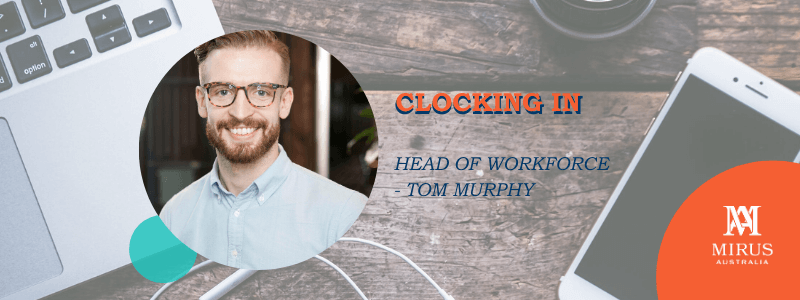Clocking In with Tom Murphy
May 5, 2020 | Uncategorised

Clocking in and out is a critical feature of any roster management platform. Knowing you have the right staff in the right place at the right time is important for payroll, governance, and the safety and welfare of your staff and ultimately the people you provide care for.
Have you ever considered exactly how your staff clock in?
At Mirus Australia, human centred design is core to what we do. The design process for Mirus Works! was no different, which is why we considered all options for clocking in before committing to the final design. For example, after working with our clients on biometrics, we decided to give staff the option to clock in and out on their own mobile devices to overcome some of the common hurdles listed below.
Beat the queue:
In the field, we often observed there were many staff arriving at the same time to start their shift. Cue anxious looks from the staff who patiently waited to clock in at the only scanning terminal. This can result in a considerable number of exceptions for the roster clerk to manage and employees missing out on hard-earned pay if they clock in late.
Goldilocks scanners:
Next to the scanner, you can usually find a set of guidelines for using it to minimise the chance of a scan not working.
This presents another challenge: they can be unreliable. For each successful scan, you must avoid bright lights whilst making sure your finger is not too dry and not too wet, not too hot and too cold, and apply just the right amount of pressure. Just a handful (ahem!) of reasons that can cause queues at clock-in time.
Bacteria begone:
With dozens of staff using them every day, finger scanners are a breeding ground for bacteria. In fact, a 2019 study of bacteria on fingerprint scanners concluded they can harbour a variety of potentially drug resistant bacteria. One solution to this is the use of hand sanitiser, however the cruel irony is that using hand sanitiser can cause a scan to fail.
Not ideal when there’s a queue forming behind you.
Biometric consent:
In order to use biometric attendance tracking, staff data must be stored. The storing of this sensitive data presents a hurdle, namely consent. What happens if someone decides they don’t want their information stored?
In 2019, a former Sawmill employee was found to be unfairly dismissed after being fired for not consenting to provide his biometric data. The commission ruled that the employer’s scanning policy contravened the Privacy Act.
Obtaining consent to collecting this sensitive information then is vital.
On that note, the Privacy Act also requires the data to be encrypted and stored securely in Australia. With cybercrime on the rise, ensuring you have the right protocols for this is another consideration that needs to be managed. You can read about Mirus Australia’s approach to data privacy by clicking here, because even though we love data – not all data should be unlocked.
Do you experience similar challenges with clocking in? Please get in touch with Tom to discuss or log a support request at the Mirus Client Centre.
Tom Murphy is Head of Workforce Management at Mirus Australia and with his team, they are optimising staff coverage to the care needs of a provider’s residents, minimising the complexity of interpreting awards and integrate technology for improved financial sustainability in aged care.
Change may suck, so we’re not going anywhere. Please get in touch with us to find out more about Mirus Works! or please connect with Tom via LinkedIn


